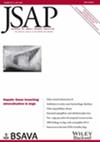Diagnostic yield of percutaneous, ultrasound-guided, fine needle aspirates of the gastrointestinal wall: a retrospective analysis of 152 samples
Abstract
Objectives
The aim was to assess the technical success of percutaneous ultrasound-guided fine needle aspirates of gastrointestinal wall lesions and evaluate predictors of success. Secondary aims included comparing the cytological diagnosis with histopathology, evaluating the utility of concurrent locoregional lymph node cytology and assessing the procedure's complication rate.
Material and Methods
Gastrointestinal wall cytology from 75 dogs and 70 cats obtained between 2018 and 2023 were reviewed and categorised as successful (resulting in a diagnostic cytology report) and accurate (resulting in the correct diagnosis when compared to histopathology). Unsuccessful fine needle aspirates, not submitted for cytology, were not recorded. Variables recorded included animal signalment, lesion and lymph node's appearance on ultrasound, size, location, number of smears submitted and experience of the ultrasonographer.
Results
One hundred and fifty-two reports were analysed. Eighty-eight (58%) were successful: three normal epithelium, 21 inflammatory processes and 64 neoplasms. Variables associated with increased technical success included description of a mass, higher number of slides submitted and thickness of gastrointestinal lesion on ultrasound. Comparison with histopathology, performed for 17 lesions, showed discrepancies in eight, complete agreement in seven and partial in two. Eighty-four loco-regional lymph nodes were sampled, of which, 67 were successful (80%) and 52 brought additional clinical information (supporting GI wall cytology or diagnosing neoplasia not identified on GI wall cytology). No complication strictly attributable to gastrointestinal wall sampling was reported but when possibly related, death of the patient occurred in 2.5% of cases.
Clinical Significance
Ultrasound-guided fine needle aspirate of gastrointestinal wall had moderate accuracy and was unsuccessful in 42% of cases, but technical success increased when sampling mass lesions, thicker intestinal layers and submitting more slides.

 求助内容:
求助内容: 应助结果提醒方式:
应助结果提醒方式:


